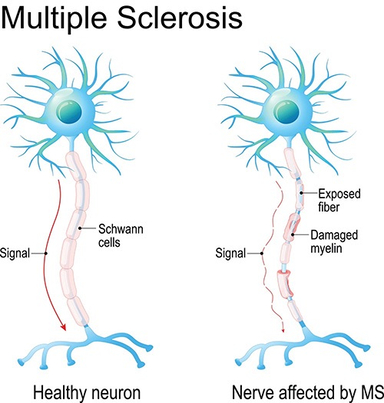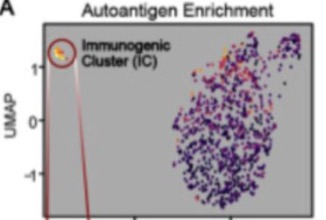•
Multiple sclerosis is an autoimmune and chronic disease that increases each year in the UK by 7,000 cases, and 130,000 people are currently affected by the disease. It is caused by B cells, Helper-T cells and macrophages (phagocytes that can become antigen-presenting cells, useful in the cell-mediated response), passing the blood-brain barrier, which is an extremely selective partially permeable layer of endothelial cells that dictates the movement of key substances from the bloodstream to the central nervous system in the brain.A destructive immune response on the myelin sheath of nerves in the brain can lead to exposed fibre and unmyelinated sections of nerve cells as shown in Figure 1, greatly reducing the electrical transmission speeds of impulses as they are no longer insulated. Its potential severity, although rare, is due to its holistic impact on the brain, affecting the cerebellum and white matter in the brain, involved in balance and movement coordination, leading to difficulty walking and muscle spasms, and the optic nerve, leading to blurred vision.
A recent study conducted by researchers in theUniversity of California have used a protein screening technique called "phage display immunoprecipitation sequencing (PhIP-Seq)" in order to create a list of autoantibodies that directly cause Multiple Sclerosis.The technique begins with 'Customised DNA synthesis', whereby the researchers collected base sequences of thousands of antiviral antigens, and are injected into the genome of a virus that infects and reproduces in a host bacteria cell. The genome codes for the specific antiviral antigen it was injected with, and that is presented on the surface of the capsid of the virus. The final detection step is somewhat similar to a direct ELISA test, the autoantibodies bind to antigens presented by the virus that they are complementary to, but each well has all the antiviral antigens tested instead of one in a direct ELISA test. The DNA in the virus that is binded to the autoantibody is analysed by a DNA sequencing machine, providing graphical analysis as shown in Figure 2 and 3.
As shown on Figure 2, the UMAP (statistical display designed to separate and group clusters that might be in common) illustrates a unique immunogenic cluster of autoantigens, that were complementary in tertiary structure to autoantibodies of 10% of MS patients in the sample of 250 MS patients the researchers used. The study used PhiP-Seq on samples 5 years before diagnosis, and compared the protein matches to samples 1 year after diagnosis, to investigate the onset of the autoantibodies. A key finding of the Immunogenic Cluster is its presence up to 5 years before diagnosis, and it stayed consistent with the samples after diagnosis, displaying the usefulness of the set of autoantibodies as biomarkers to test for MS, as their levels are preserved.
A key finding of the immunogenic Cluster is its presence up to 5 years before diagnosis, and it stayed consistent with the samples after diagnosis, displaying the usefulness of the set of autoantibodies as biomarkers to test for MS, as their levels are preserved.Furthermore, as illustrated on Figure 3, a statistically significant presence of these autoantibodies were only seen in the MS sample on the left, and this absence in the healthy control group sample (on the right) illustrates a very high degree of accuracy in predicting MS. The main aid to diagnosis currently is an MRI, which can detect scarring and inflammation in the brain due to the autoimmune response by the body, however a PhiP-Seq is an easier, cheaper form of detection through blood tests that can detect some MS cases at a much earlier Pre-onset stage than MRI.However, the main limitation, which future studies need to address is the fact that the autoantibodies are present in 10% of MS cases, so further research with a larger, more reliable sample size must aim to validate this figure, which is key in determining its usefulness as a biomarker which can be used in conjunction with MRI scans. Another limitation is that not all antiviral antigens were used in the PhiP-Seq tests, narrowing the scope of potential autoantibodies detected, as there could be autoantibodies that cause MS that had no autoantigen to bind to, so further studies should look to expand the range of the 'Immunogenic Cluster'. Looking towards the future, this study should inspire research into other biomarkers of MS that cause the 'other 90%' of MS cases, in order to create a more precise group of tests that can be tested regularly and aid early detection and treatment, as for now a cure is yet to be discovered.
Glossary:
Immunogenic: the ability of a non-self substance (in this instance autoantigens), to stimulate an immune response
Autoantibodies: a major cause of autoimmune diseases, due to antibodies produced against 'self' antigens (antigens on your own cells).
White matter: an area of the brain and spinal cord filled with bundles of axons that connect grey matter areas of the brain, as well as allowing nerve transmission between the brain and spinal cord.
Myelin sheath: a layer of proteins and lipids that insulate and protect the axon, as well as increase neurotransmission speeds.
Direct ELISA test: an ELISA test that quantifies the concentration of a protein, using only one antibody, instead of two in an indirect ELISA
Fig. 1
fig 2
fig 3
Reference List:
The Immune System and Multiple Sclerosis | MSAA
[Internet]. Available from: httos://mymsaa.org/ms-
information/overview/immune= system/witext=With920MS962C9620damaging%20immun
e%2Dsystem
MS in the UK | Multiple Sclerosis Society UK [Internet]. www.mssociety.org.uk. Available from:
https://www.mssociety.org.uk/what-we-do/our-work/our
evidence/mssin-thes
uklietext=Incidence%20and%20prevalence
Johns Hopkins Medicine. Multiple Sclerosis (MS) [Internet].
John Hopkins Medicine. 2022. Available from:
https://www.hopkinsmedicine.org/health/conditions-and-
diseases/multiple-sclerosis.ms
Using UMAP for Clustering — umap 0.5 documentation [Internet). umap-learn.readthedocs.io. Available from:
https://umap:
learn.readthedocs.io/en/latest/clustering.html
Signs of multiple sclerosis show up in blood years before symptoms [Internet]. ScienceDaily. Available from:
https://www.sciencedaily.com/releases/2024/04/24041913
1815.htm
Zamecnik CR, Sowa GM, Abdelhak A, Dandekar R, Bair RD, Wade KJ, et al. An autoantibody signature predictive for multiple sclerosis. Nature Medicine [Internet]. 2024 Apr 19;
Available from: https://pubmed.ncbi.nim.nih.gov/38641750/
White matter [Internet]. Kenhub. Available from:
https://www.kenhub.com/en/library/anatomy/white-matter
Synoptic Links:
Gcse
4.3.1.6 Human defence systems: phagocytosis and the role of lymphocytes in antibody production
4.5.2.1 Structure and function: the structure of nerves and the brain
A-Level
3.2.4 Cell recognition and the immune system: ELISA
testing, specific immune responses
3.6.2.1 Nerve impulses (A-level only): factors affecting nerve impulse transmission, and the function of the myelin sheath
See More Posts
Copyright © 2021 Govest, Inc. All rights reserved.




